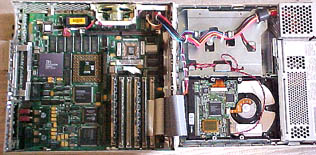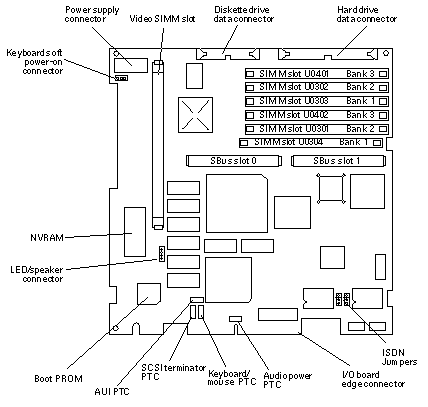SUN4/30 SparcStation LX
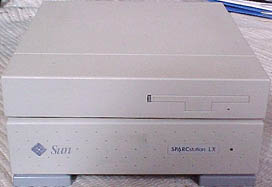
SUN4/30 SparcStation LX

Hardware FAQ Info
SPARCstation LX (4/30) Processor(s): microSPARC @ 50MHz, 59.1 MIPS, 4.6 MFLOPS, 26.4 SPECint92, 21.0 SPECfp92, 626 SPECintRate92, 498 SPECfpRate92 Chassis type: lunchbox Bus: SBus @ 25MHz (?), 2 slots Memory: 96M physical Architecture: sun4m Notes: Sun4m architecture, but no Mbus. Uniprocessor only. Takes pairs of 4M or 16M 60ns SIMMs. Soldered CPU chip. Onboard cgsix framebuffer, 1M VRAM standard, expandable to 2M. DBRI 16-bit audio/ISDN chip. First supported by special SunOS release 4.1.3c, then general release 4.1.3_U1.
External Views
The Classic and LX were the end of the line for the "Lunchbox" chassis. Sun managed to squeeze a large amount of computer into a very small package, but as a result, there are changes to the chassis as compared to an IPC or IPX machine.
For example, because there are way more ports on the rear than an IPC or IPX would have, the rear "feet" are not feet at all, but simply rubber pads with a bit of purple plastic around the outer edges of the case the make them look like feet.
Although Sun eventually used rubber pads with all their machines (the most notable being the Aurora chassis used on the Sparcstation 4, 5 and 20), here it seems a little weird, only because the front feet are the same as earlier IPC chassis.
Also, with this much computer, cooling and power supply requirements become a signifigant issue. A completely 'loaded' LX probably generates quite a bit of heat, and taxes it's powersupply to the maximum.
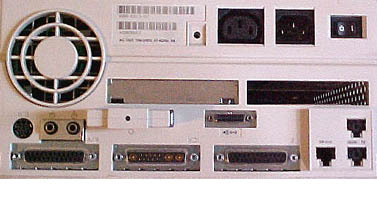
Motherboard
Here's a large (250k) image of the motherboard, identifying major components. Click on this image to see the huge one.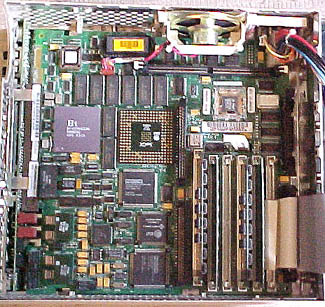
The SparcStation Classic and the SparcStation LX are very similar. The LX differs from the Classic by virtue of having a built-in CG6 framebuffer, while the Classic has a built-in CG3.
One other notable difference between the two is that the Classic has 8-bit audio, while the LX features 16-bit audio. In my humble opinion, the LX is a superior "desktop" machine versus the Sparcstation Classic. However, both machines share the same chassis, CPU and motherboard (for the most part).
Both machines can make use of 96MB of RAM, and I believe that both can be "hacked" to accept 128MB of RAM by using 32MB SIMMs in the first RAM bank.
The 50Mhz Microsparc is decent for lightweight use, but these early Microsparcs were notoriously slow -- an IPX, even though it's a earlier machine, can almost keep up with the LX, and an IPX equipped with the Weitek Power-Up will outperform an LX.
However, with it's built-in framebuffer, which provides decent graphics speed, the LX is a very useable machine with nothing in except the mainboard. You really don't need any Sbus cards in it to make effective use of it.
Also the Sun 4m Microsparc architecture is still supported by newer versions of Solaris, while the older 4c architecture of the IPX is not.
A note about the framebuffer: According to David Tong's Framebuffer FAQ, the CG6 on the LX is "upgradable" via a VSIMM (shown to the left). With this extra SIMM, the LX can support a higher refresh rate. It will not allow you to increase the number of colors displayed, so don't bother asking. This VSIMM goes into the special slot for it, by the speaker, and NOT into one of the regular RAM slots.
Here are the known resolutions:1024 x 768 @ 77 1152 x 900 @ 66 1152 x 900 @ 76 1280 x 1024 @ 67 1280 x 1024 @ 76 -- LX with 1Mb VSIMM only 1600 x 1280 @ 76 1600 x 1280 @ 76 -- LX with 1Mb VSIMM onlyPlease note that 1152 x 900 @66mhz is the default, unless you or someone else has changed the NVRAM settings.
Service Manual
If you have Adobe Acrobat Reader, here's a PDF (640k), of the Sun Sparc LX Service Manual.
Also, here's a link to Sun's website that has detailed information for the Classic/Classic-X/LX Lunchbox series of machines.
